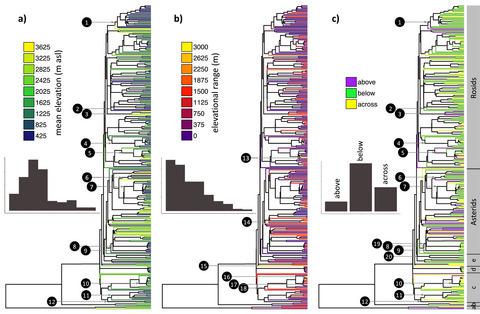当前位置:
X-MOL 学术
›
Biotropica
›
论文详情
Our official English website, www.x-mol.net, welcomes your feedback! (Note: you will need to create a separate account there.)
Evolutionary heritage shapes tree distributions along an Amazon‐to‐Andes elevation gradient
Biotropica ( IF 2.1 ) Pub Date : 2020-10-06 , DOI: 10.1111/btp.12843 Andy R. Griffiths 1 , Miles R. Silman 2 , William Farfán Rios 3, 4, 5 , Kenneth J. Feeley 6, 7 , Karina García Cabrera 2 , Patrick Meir 1, 8 , Norma Salinas 9 , Kyle G. Dexter 1, 10
Biotropica ( IF 2.1 ) Pub Date : 2020-10-06 , DOI: 10.1111/btp.12843 Andy R. Griffiths 1 , Miles R. Silman 2 , William Farfán Rios 3, 4, 5 , Kenneth J. Feeley 6, 7 , Karina García Cabrera 2 , Patrick Meir 1, 8 , Norma Salinas 9 , Kyle G. Dexter 1, 10
Affiliation

|
Understanding how evolutionary constraints shape the elevational distributions of tree lineages provides valuable insight into the future of tropical montane forests under global change. With narrow elevational ranges, high taxonomic turnover, frequent habitat specialization, and exceptional levels of endemism, tropical montane forests and trees are predicted to be highly sensitive to environmental change. Using plot census data from a gradient traversing > 3,000 m in elevation on the Amazonian flank of the Peruvian Andes, we employ phylogenetic approaches to assess the influence of evolutionary heritage on distribution trends of trees at the genus‐level. We find that closely related lineages tend to occur at similar mean elevations, with sister genera pairs occurring a mean 254 m in elevation closer to each other than the mean elevational difference between non‐sister genera pairs. We also demonstrate phylogenetic clustering both above and below 1,750 m a.s.l, corresponding roughly to the cloud‐base ecotone. Belying these general trends, some lineages occur across many different elevations. However, these highly plastic lineages are not phylogenetically clustered. Overall, our findings suggest that tropical montane forests are home to unique tree lineage diversity, constrained by their evolutionary heritage and vulnerable to substantial losses under environmental changes, such as rising temperatures or an upward shift of the cloud‐base.
中文翻译:

进化遗产塑造了亚马逊到安第斯山脉海拔梯度上的树木分布
了解进化约束如何塑造树木世系的海拔分布,可为全球变化下热带山地森林的未来提供有价值的见解。由于海拔高度范围狭窄,生物分类学更新率高,生境专业化程度高以及地方特有的特殊水平,热带山地森林和树木对环境变化高度敏感。使用来自秘鲁安第斯山脉亚马孙腹地海拔超过3,000 m的坡度的人口普查数据,我们采用系统发育方法评估了进化遗产对属水平上树木分布趋势的影响。我们发现,密切相关的世系往往会以相似的平均海拔出现,姐妹属对的平均海拔高度比非姐妹属对之间的平均海拔差异高254 m。我们还证明了1,750 m asl之上和之下的系统发育聚类,大致相当于基于云的过渡带。遵循这些总体趋势,有些谱系出现在许多不同的海拔高度。但是,这些高度可塑性的谱系不是系统发育上的聚类。总体而言,我们的发现表明,热带山地森林是独特的树系多样性的家园,受其进化传承的约束,并且在环境变化(例如温度升高或云层向上移动)下容易遭受重大损失。大致对应于基于云的生态交错带。遵循这些总体趋势,有些谱系出现在许多不同的海拔高度。但是,这些高度可塑性的谱系不是系统发育上的聚类。总体而言,我们的发现表明,热带山地森林是独特的树系多样性的家园,受其进化传承的约束,并且在环境变化(例如温度升高或云层向上移动)下容易遭受重大损失。大致对应于基于云的生态交错带。遵循这些总体趋势,有些谱系出现在许多不同的海拔高度。但是,这些高度可塑性的谱系不是系统发育上的聚类。总体而言,我们的发现表明,热带山地森林是独特的树系多样性的家园,受其进化传承的约束,并且在环境变化(例如温度升高或云层向上移动)下容易遭受重大损失。
更新日期:2020-10-06
中文翻译:

进化遗产塑造了亚马逊到安第斯山脉海拔梯度上的树木分布
了解进化约束如何塑造树木世系的海拔分布,可为全球变化下热带山地森林的未来提供有价值的见解。由于海拔高度范围狭窄,生物分类学更新率高,生境专业化程度高以及地方特有的特殊水平,热带山地森林和树木对环境变化高度敏感。使用来自秘鲁安第斯山脉亚马孙腹地海拔超过3,000 m的坡度的人口普查数据,我们采用系统发育方法评估了进化遗产对属水平上树木分布趋势的影响。我们发现,密切相关的世系往往会以相似的平均海拔出现,姐妹属对的平均海拔高度比非姐妹属对之间的平均海拔差异高254 m。我们还证明了1,750 m asl之上和之下的系统发育聚类,大致相当于基于云的过渡带。遵循这些总体趋势,有些谱系出现在许多不同的海拔高度。但是,这些高度可塑性的谱系不是系统发育上的聚类。总体而言,我们的发现表明,热带山地森林是独特的树系多样性的家园,受其进化传承的约束,并且在环境变化(例如温度升高或云层向上移动)下容易遭受重大损失。大致对应于基于云的生态交错带。遵循这些总体趋势,有些谱系出现在许多不同的海拔高度。但是,这些高度可塑性的谱系不是系统发育上的聚类。总体而言,我们的发现表明,热带山地森林是独特的树系多样性的家园,受其进化传承的约束,并且在环境变化(例如温度升高或云层向上移动)下容易遭受重大损失。大致对应于基于云的生态交错带。遵循这些总体趋势,有些谱系出现在许多不同的海拔高度。但是,这些高度可塑性的谱系不是系统发育上的聚类。总体而言,我们的发现表明,热带山地森林是独特的树系多样性的家园,受其进化传承的约束,并且在环境变化(例如温度升高或云层向上移动)下容易遭受重大损失。


























 京公网安备 11010802027423号
京公网安备 11010802027423号